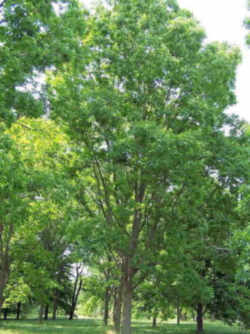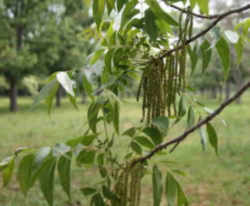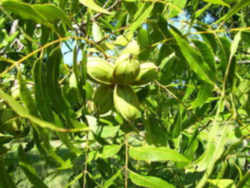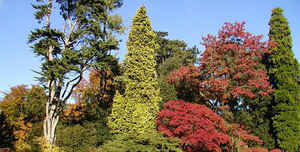
Texas Symbols
Texas State Tree
Pecan

(Juglandaceae Carya illinoinensis )
Adopted in 1919.
The pecan, (Juglandaceae Carya illinoinensis,) is a large tree native to North America. The pecan became the Texas state tree by act of the Texas Legislature in 1919 when Governor William Pettus Hobby signed Senate Bill No. 317 on March 20, 1919. Governor James Hogg favored the tree so much that he requested that one be planted at his gravesite.
It bears sweet edible nuts, deep brown in color, that range from 1 to 2 inches in length. Texas is the largest producer of native pecans, and is second only to Georgia in the production of hybrid (orchard grown) varieties.
Texas State Tree: Pecan

"Pecan" is from an Algonquian word, meaning a nut requiring a stone to crack. The mature pecan tree is usually 70 to 100 feet tall, as shown above, but can grow as tall as 150 feet and higher. The native pecan trees shown are estimated to be over 150 years old. Their trunks are more than three feet in diameter.
Pecan is one of the better-known pecan hickories. It is also called sweet pecan and in its range where Spanish is spoken, nogal morado or nuez encarcelada. The early settlers who came to America found pecans growing over wide areas. These native pecans were and continue to be highly valued as sources of new varieties and as stock for selected clones. Besides the commercial edible nut that it produces, the pecan provides food for wildlife. Pecans are an excellent multipurpose tree for the home landscape by providing a source of nuts, furniture-grade wood, and esthetic value.
Characteristics of the Pecan:

Pecans are part of the Walnut family of Juglandacae. They are large, deciduous trees that can grow over 100 feet tall. "Pecan is usually found in the deep rich soils associated with streams and river bottoms in East and Central Texas but it has been widely planted across the state outside its natural range. Pecan wood has a light reddish-brown sapwood and a darker heartwood. It is not as strong as other hickories and is used primarily for flooring and veneer for paneling and furniture. This is the largest and fastest growing hickory and has become widely cultivated outside of its natural range for the nutrient-rich nuts. It is relatively free of serious pests and diseases but it is hard to transplant because of the long taproot. Webworms can be a problem on some trees. The nuts were a favorite food of the Indians and are an important food source for many wildlife species.
Pecans used to be so abundant that large trees were often cut down to harvest a single nut crop. This short-sighted, wasteful practice illustrates how some of Texas' virgin forests were exploited for profit. The leaves and bark have been used medicinally as an astringent. It is rumored that the high tannic acid content of the leaves inhibits growth of some plants beneath the trees. Pecan is the state tree of Texas. The state champion Pecan is located in Franklin County and is 111 inches in circumference, 115 feet tall, and has a crown spread of 66 feet.
- Leaf: Alternate, pinnately compound with 9 to 15 finely serrate and often curved leaflets, 12 to 18 inches long.
- Flower: Male flowers in hanging, yellow-green catkins, often in pairs of three (4 to 5 inches long). Females are small and yellowish green, 4-angled.
- Fruit: Large, oblong, brown, splotched with black, thin shelled nuts, 1 ? to 2 inches long, husks are thin, usually occur in clusters on trees. Mature in September and October.
- Twig: Moderately stout, light brown, fuzzy particularly, when young; leaf scars large and three lobed; buds are yellowish brown to brown, hairy, terminal buds ? to ? inch long.
- Bark: Smooth when young, becoming narrowly fissured into thin broken strips, often scaly.
- Form: A large tree (can reach heights well over 100 feet) with spreading crown when in the open.
Texas Chapter 97 (Senate Bill No. 317), 36th Legislature, Regular Session (1919) p. 234
NAMING THE PECAN AS THE TEXAS STATE TREE.
[S. B. No. 317.]
CHAPTER 97.
An Act naming the Pecan as the Texas State tree and declaring an emergency.
Be it enacted by the Legislature of the State of Texas:
SECTION 1. That the Pecan Tree be, and the same is hereby named and constituted the State Tree of Texas.
SEC. 2. The fact of the near approach of the end of the Session and the importance of this legislation, and the crowded condition of the calendar,
creates an emergency and imperative public necessity requiring the suspension of the Constitutional rule that bills be read on three several days,
and that this act take effect and be in force from and after its passage, and it is so enacted.
[NOTE.--S. B. No. 317 passed the Senate on March 14, 1919, by a viva voce vote; and passed the House of Representatives on March 18, 1919, by a viva
voce vote.]
Approved March 20, 1919.
Becomes effective 90 days after adjournment.
Texas Law
The law designating the pecan tree. as the official Texas state tree is found in the Texas Statutes: Government Code, Title 11, Subtitle A, Chapter 3101, Section 3101.009.
TITLE 11. STATE SYMBOLS AND HONORS; PRESERVATION
SUBTITLE A. STATE SYMBOLS AND HONORS
CHAPTER 3101. STATE SYMBOLS
Sec. 3101.009. STATE TREE.
Sec. 3101.009. STATE TREE. The state tree is the pecan tree.
Added by Acts 2001, 77th Leg., ch. 1420, Sec. 7.001, eff. Sept. 1, 2001.
Taxonomic Hierarchy: Pecan
Kingdom: Plantae - Plants
Subkingdom: Tracheobionta - Vascular plants
Superdivision: Spermatophyta - Seed plants
Division: Magnoliophyta - Flowering plants
Class: Magnoliopsida - Dicotyledons
Subclass: Hamamelididae
Order: Juglandales
Family: Juglandaceae - Walnut family
Genus: Carya Nutt. - hybrid hickory
Species; Carya illinoinensis (Wangenh.) K. Koch - pecan







